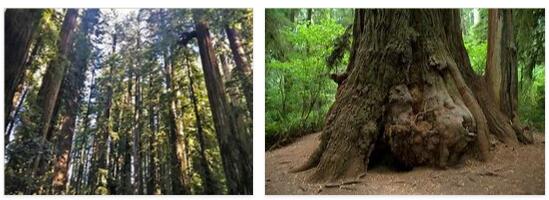The 446 km² national park protects a narrow coastal region on the North American Pacific with a unique population of coastal sequoias, the redwood trees. Only a small population of the once widespread giant trees, up to 110 m high, is left today. They are protected in several parks that together form the Redwood National Park.
Redwood National Park: Facts
| Official title: | Redwood National Park |
| Natural monument: | 80 km long and 0.3 to 14 km wide Redwood National Park including Del Norte Coast Redwoods State Park, Jedediah Smith Redwoods State Park and Prairie Creek Redwoods State Park; Established in 1968 and expanded in 1978 |
| Continent: | America |
| Country: | USA, Northeast California |
| Location: | north of San Francisco, Humboldt and Del Norte counties |
| Appointment: | 1980 |
| Meaning: | a coastal region on the North American Pacific with the world’s only population of coastal sequoia and a very remarkable marine ecosystem |
| Flora and fauna: | 865 plant species, including 699 native species; dominating the forest of coastal sequoia, sometimes also referred to as “coastal sequoia”, which can only be found on the climatically humid west coast of the USA; other tree species Douglas fir, sitka spruce, coastal fir and California laurel, small numbers of Jeffrey pines and Oregon white oaks; 75 species of mammals, including a limited number of the Roosevelt elk, mule deer, gray fox, black bear, otter, skunk, puma and sea lion; 398 native bird species such as brown pelican, peregrine falcon, guillemot and the endangered Marmelalk |
redwood
National park, world natural heritage, international biosphere reserve – all these titles were awarded to a short stretch of the North American Pacific coast that preserves a unique treasure: the last forests of the redwoods or coastal sequoia, the tallest trees in the world. From San Francisco in California north to the south of the US state of Oregon, the giant trees thrive in a narrow strip along the coast – wherever two to three meters of rain fall a year and thick banks of summer fog ensure constant moisture. The mysterious forests, inhabited only by Indians, remained hidden from white pioneers for a long time. It was not until the middle of the 19th century that gold prospectors reached this point, but they were not to find their luck on the rivers, but in the groves of the towering coastal seas. Because the giants deliver excellent timber. No wonder then that saw, ax and fire soon reigned in the Redwood Forest. After just a few decades, the former stocks had shrunk to less than a tenth due to ruthless felling.
Without private donors, this residual forest would have been destroyed, but through their targeted purchase of land, the last giant trees on earth could be preserved for posterity when the Redwoods National Park was established in 1968. Outside of this protected area, however, the “green gold” continues to be exploited. “They are not like any other tree, they are ambassadors from another time,” wrote the American author John Steinbeck, who became famous for “The Fruits of Wrath,” in 1962 of the coastal sequoia. At the visitor center of the Humboldt Redwoods State Park, a cut trunk gives an insight into the life story of a “little redwood”. The number of annual rings reveals that it began to grow in 1148 AD, at the time of America’s discovery in 1492, at 344 years of age, it was still in adolescence. and in 1776, the year of the declaration of independence, he just celebrated his 628th birthday. When this redwood fell in 1987 after “only” 839 years, it had reached a height of 90 meters and a trunk diameter of 2.70 meters. Nevertheless, he was just a “youth” among the giants, as the oldest known coastal sequel can look back on a proud 2200 years of life and the largest towers over a 30-story high-rise with its 112.10 meters! With their dimensions, the redwoods literally put everything in the shade – the thick moss cushions and fern carpets of the forest floor as well as the alpine roses. Even the sturdy hemlocks look dwarfed and lost between the straight, towering trunks of the giant Californian trees. But these are full of other surprises. For a long time, for example, it was not known that they absolutely needed fire in order to reproduce. The tiny seeds, which are produced in huge quantities, only germinate when there is free space. In the past, naturally occurring bushfires took on this task of “cleaning” the forest from undergrowth – and at the same time provided fertilization. They could not harm the trunks of the Redwoods, protected by a thick, fibrous, fox-red bark. Today, after this dependency of the coastal sequoias on fire was recognized, their survival is ensured by means of controlled “fires according to regulations”.
For many visitors, the diversity of the animal world is also unimagined: Mule deer and Roosevelt elk graze in clearings, raccoons roam the undergrowth, and amphibians such as the reddish-brown and reticulated giant pacific cross-toothed newt find a home in pools and lakes. Collared thrushes and the rare spotted owl are two of the many feathered forest guests. Brown pelicans and numerous other waterbirds and waders cavort in the sea bays and on rocky coasts, while seabirds like the little Marmelalk do not prefer coastal cliffs, but rather the “forest of giants” as a nesting place.
